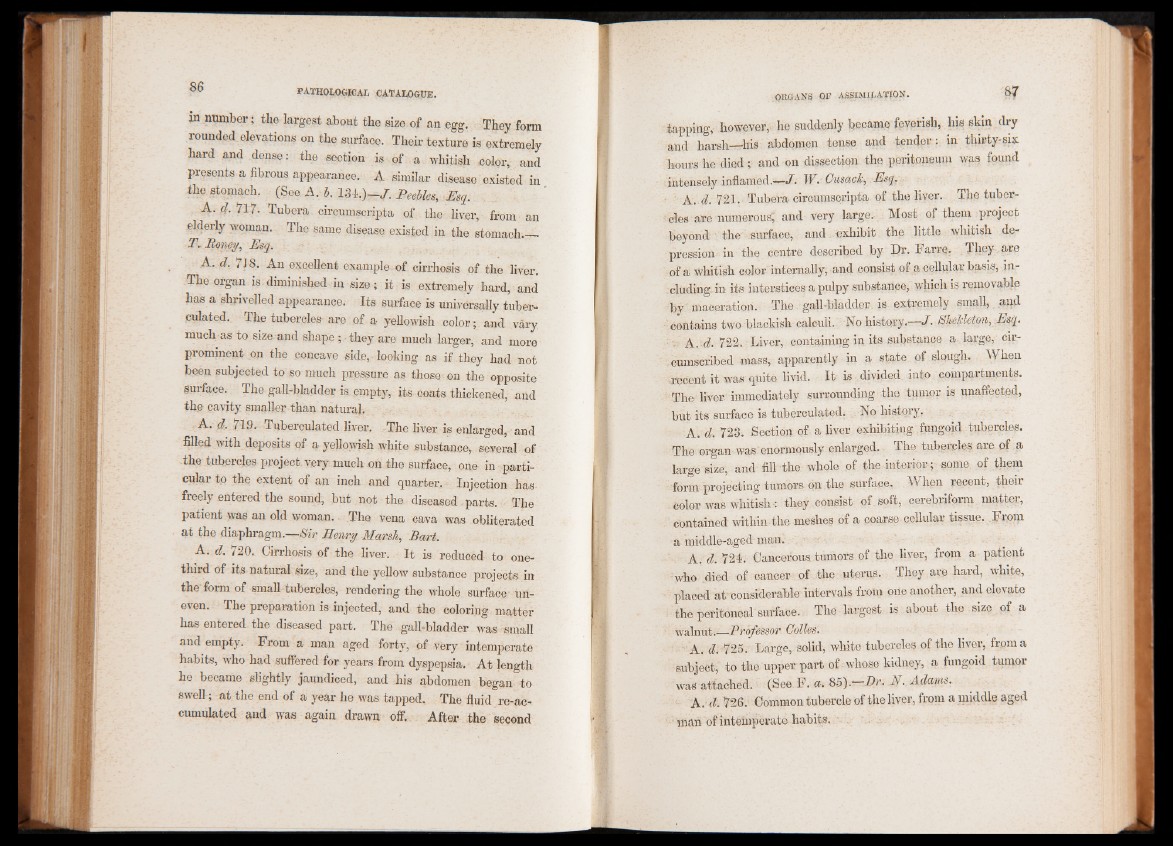
in number; the largest about the size of an egg. They form
rounded elevations on the surface. Their texture is extremely
hard and dense: the section is of a whitish color, and
presents a fibrous appearance. A similar disease existed in
the stomach. (See A. b. 134.)-/. Peebles, Esq.
A. / 717. Tubera . circumscripta of the fiver, from an
elderly woman. The same disease T. Roney, Esq. existed in the stomach__
A. d. 718, An excellent example of cirrhosis of the liver.
The organ is diminished in size; it is extremely hard, and
has a shrivelled appearance. Its surface is universally tuber-
pulated. The tubercles are of a yellowish color; and vary
much as to size and shape ; they are much larger, and more
prominent on the concave side,- looking as if they had not
been subjected to so much pressure as those on the opposite
Surface. The gall-bladder is empty, its coats thickened, and
the cavity smaller than natural,
A. d. 719. Tuberculated fiver. The liver is enlarged, and
filled with deposits of a yellowish white substance, several of
the tubercles project very much on the surface, one in particular
to the extent of an inch and quarter. Injection has
freely entered the sound, but not the diseased parts. The
patient was an old woman. The vena cava was obliterated
at the diaphragm.—Sir Henry Marsh,, Bart.
A. d. 720. Cirrhosis of the fiver. It is reduced to one-
third of its natural size, and the yellow substance projects in
the form of small tubercles, rendering the whole surface uneven.
The preparation is injected, and the coloring matter
has entered the diseased part. The gall-bladder was small
and empty. From a man aged forty, of very intemperate
habits, who had suffered for years from dyspepsia. At length
he became slightly jaundiced, and his abdomen began to
swell; at the end of a year he was tapped. The fluid re-accumulated
and was again drawn off. After the second
tapping, however, he suddenly became feverish, his skin dry
and harsh—-his abdomen tense and tender : in thirty-six
hours he died; and on dissection the peritoneum was found
intensely inflamed.—/ IF". Cusack, Esq..
• A. d. 721. Tubera circumscripta of the liver. The tubercles
are numerous; and very large. Most of them project
beyond the surface, and . exhibit the little whitish depression
in the centre described by Dr. h’arre. They are
of a whitish color internally, and consist of a cellular basis, including
in its interstices a pulpy substance, which is removable
by maceration. The gall-bladder is extremely small, . .and
contains two blackish calculi. No history.—/. Skeleton, Esq.
; A. d. 722, Liver, containing in its substance a. large, cjr-
cumscribed mass, apparently in a state of slough. When
•recent it was quite livid. It is divided into compartments.
The liver immediately surrounding the tumor is unaffected,
but its surface is tuberculated, No history. . .. : -
A. d. 723. Section of a liver exhibiting fungoid tubercles.
The organ was enormously enlarged. The tubercles are of a
large size, and fill the whole of the interior; some, of them
form projecting tumors on the surface, W ken recent, their
color was whitish : they consist of . soft, cerebriform matter,
' contained within the meshes of a coarse cellular tissue. Frqm
a middle-aged man.
A. d. 724. Cancerous tumors of the liver, from a patient
who died of cancer of the uterus. They are hard, white,
placed at-considerable intervals from one another, and elevate
the peritoneal surface. The largest is about the size of a
walnut.—Professor Colles.
A. d. 725. Large, solid, white tubercles of the liver, from a
subject, to the upper part of whose kidney, a fungoid tumor
was attached. (See F. a. 85). Dr. Ar. Adams.
A. d. 726.' Common tubercle of the liver, from a middle aged
man of intemperate habits.